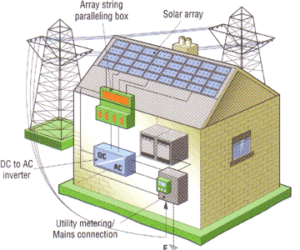 “Net metering” is the practice of running a meter for energy use in reverse when a user feeds energy into the system rather than drawing it out, and billing the user for the “net” amount of energy drawn. It’s used in home energy systems that are “on the grid,” which means that the home is still connected to the energy utility’s system and draws upon commercial energy production for convenience.
“Net metering” is the practice of running a meter for energy use in reverse when a user feeds energy into the system rather than drawing it out, and billing the user for the “net” amount of energy drawn. It’s used in home energy systems that are “on the grid,” which means that the home is still connected to the energy utility’s system and draws upon commercial energy production for convenience.
A net metering system feeds power from the home production system into the grid, which the utility can sell to other customers. During times when the home is producing energy (usually from a solar or wind power system), and more energy is being fed into the grid than
taken from it, the utility’s accounting system “pays” the customer for this energy in the form of a credit that can be used to buy energy from the utility.
During times when more energy is being drawn from the grid than added to it, the credit is reduced to pay for the energy consumed. At the end of the month, if more energy has been consumed than produced by the customer, the utility charges the customer for the difference. If more energy has been produced than consumed, the utility pays the customer for the difference –
Advantages
The great advantage of net metering is convenience. A home energy system with net metering does not have to produce 100% of the power that the home needs. Also, with net metering it’s unnecessary to have much of the auxiliary equipment that is used with an off-
This is especially useful because a home energy system typically doesn’t produce its energy at convenient times. A solar system, for example, has maximum production capacity during the daylight hours, but most energy use happens at night. That’s when artificial lighting is needed. It’s also when people are usually at home. In the winter months, it’s the time of the greatest energy cost for heating
the home. With an on-
Net metering, despite the name, does not require any special equipment. Electric meters are generally configured to be able to run in either direction. To implement net metering, an electric utility would need only to make use of accounting procedures and appropriate policies.
Disadvantages
Net metering has some disadvantages for the individual as well. One of these is that you are tied to the grid and to some extent still dependent on the utility. If the utility changes its net-
Theoretically, another disadvantage could arise if too many customers install home energy systems and make use of net metering. Currently, net metering is feasible because most energy customers don’t have home energy systems. The bulk of the utility’s electricity is produced at commercial facilities, not by home systems. This gives the utility plenty of power to provide for net-
States That Allow Net Metering
In the United States, by a federal law passed in 2005, public electric utilities must offer net metering to customers on request. However, the federal law does not set standards for net metering and these vary widely from state to state.
This is one of the relatively few areas in regard to renewable energy where U.S. law and policy is more enlightened than most of the advanced world. Outside the U.S., currently net metering is being implemented in France, Denmark, Italy, and Spain among EU countries; to a limited degree in Ontario, British Columbia, and New Brunswick, Canada; and Victoria and Queensland, Australia.
Off-
The alternative to an on-
the convenience benefits of an on-
